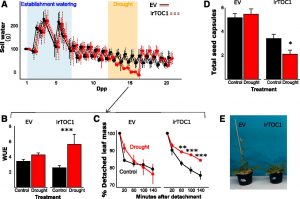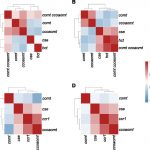A Circadian Clock Protein Regulates Fitness under Water Limitation
The circadian clock of plants coordinates many molecular, physiological and metabolic processes to optimize the plant’s health and survival in an  ever-changing environment. The core circadian clock component TIMING OF CAB EXPRESSION1 (TOC1) integrates environmental stress responses in plants through its effects on abscisic acid signaling and growth suppression. The interaction of TOC1 with PHYTOCHROME B (PHYB) under the far-red light conditions that characterize the end-of-day, when TOC1 is expressed, suggest a connection between circadian control of light responses and sensitivity to ABA. Using micrografting and experimentally controlled drought scenarios in both field and glasshouse experiments, Valim et al. (10.1104/pp.19.00286) used the desert annual, Nicotiana attenuata, to explore the consequences of silencing TOC1 on fitness in the face of drought. TOC1-silenced plants displayed altered physiological responses to drought, including decreased leaf water loss and increased water-use efficiency. However, the authors found that TOC1-silenced plants incurred severe fitness disadvantages under synchronized drought stress and a controlled watering regime. Despite marked decreases in leaf water loss, TOC1-deficient lines failed to maintain fitness in response to drought stress as measured by total seed capsule production. Restoring TOC1 transcript levels in shoots via micrografting was sufficient to restore wild-type drought responses under field conditions. Microarray data identified a coexpression module in leaves strongly linking red and far-red light signaling to drought responses in a TOC1-dependent manner, but experiments with phytochrome-deficient lines revealed that the effects of TOC1 deficiency under drought cannot be attributed to changes in red/far-red light perception alone. These results reveal a role for TOC1 in integrating developmental as well as physiological responses for maintaining fitness in the face of drought.
ever-changing environment. The core circadian clock component TIMING OF CAB EXPRESSION1 (TOC1) integrates environmental stress responses in plants through its effects on abscisic acid signaling and growth suppression. The interaction of TOC1 with PHYTOCHROME B (PHYB) under the far-red light conditions that characterize the end-of-day, when TOC1 is expressed, suggest a connection between circadian control of light responses and sensitivity to ABA. Using micrografting and experimentally controlled drought scenarios in both field and glasshouse experiments, Valim et al. (10.1104/pp.19.00286) used the desert annual, Nicotiana attenuata, to explore the consequences of silencing TOC1 on fitness in the face of drought. TOC1-silenced plants displayed altered physiological responses to drought, including decreased leaf water loss and increased water-use efficiency. However, the authors found that TOC1-silenced plants incurred severe fitness disadvantages under synchronized drought stress and a controlled watering regime. Despite marked decreases in leaf water loss, TOC1-deficient lines failed to maintain fitness in response to drought stress as measured by total seed capsule production. Restoring TOC1 transcript levels in shoots via micrografting was sufficient to restore wild-type drought responses under field conditions. Microarray data identified a coexpression module in leaves strongly linking red and far-red light signaling to drought responses in a TOC1-dependent manner, but experiments with phytochrome-deficient lines revealed that the effects of TOC1 deficiency under drought cannot be attributed to changes in red/far-red light perception alone. These results reveal a role for TOC1 in integrating developmental as well as physiological responses for maintaining fitness in the face of drought.



